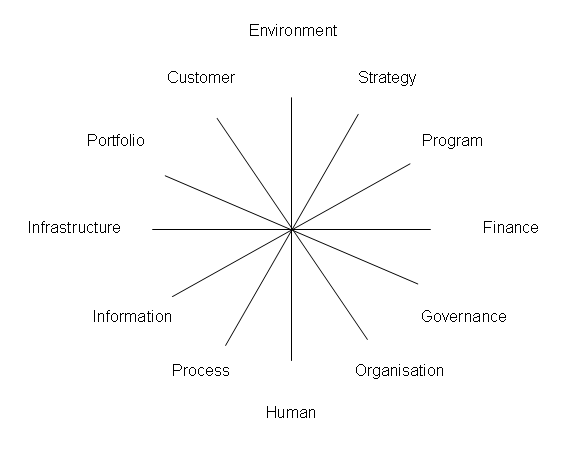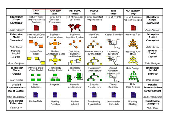Social Enterprise Architecture Research is an ongoing program in pursuit of knowledge to understand the emerging postmodern enterprise and define an architecture framework for social enterprises in developing economies.
The Challenge and Opportunity in Enterprise Architecture
Every enterprise has an architecture whether or not it has a defined Enterprise Architecture program or not. A well-documented architecture is a logical organization of information pertaining to the following multi-level, multi-dimensional, enterprise-wide elements:
- Strategic goals, objectives, and strategies
- Business rules and measures
- Information requirements
- Application systems
- Relationships between applications and data elements
- Technology infrastructure
 EA Portals and metadata repositories provide tools for searching artifacts and information pertaining to the
enterprise, its objects and elements and how these are inter-dependent, associated, mapped and linked.
EA Portals and metadata repositories provide tools for searching artifacts and information pertaining to the
enterprise, its objects and elements and how these are inter-dependent, associated, mapped and linked.
Why research Enterprise Architecture? Because EA is evolving and it involves the development of:
- Cognitive skills applied to abstraction, visual modeling, analysis and design.
- Inter-personal skills to interact with stakeholders who have specific perspectives and view points.
- Ability to develop a technical understanding and experience with complex systems and technology.
- The ability to share knowledge, communicate, mentor and educate.
Architecture intensive disciplines encompass a wide range of competencies which include knowledge management, change management and project management. To develop systems thinkers such as enterprise, business and technology architects, particularly from our disadvantaged communities represents not only a challenge but also an opportunity.
Postmodernism in Enterprise Architecture
Our research into postmodernism in EA involves developing our understanding of the relationship between social theory and the enterprise. Traditional western views on Enterprise Architecture are influenced by modernist thinking and concepts. The social pre-occupation of the last century has been on the balance between man and machine. Computing was borne of this period and much of the thinking in IT reflects this structured approach.
We believe that public and private enterprises are in the process of transition towards postmodern enterprise architecture. Globalisation, the environment and the advent of the internet is part of the postmodern trend towards more open social systems. The emerging enterprise model is that of a social enterprise, not purely profit driven but as much about sustainability and socially and environmentally aware. The reference patterns for such an enterprise is in natural architecture patterns found in our natural environment and in human-centric value systems.
Social software and technology movements have influenced enterprise systems and vice versa. We are involved in both social and enterprise systems development and are keenly evaluating the evolution of social and enterprise systems. How does the evolution of the personal web and portals, mobility, convergence, social utilities and free and open source software impact public and private enterprises? How will mature, stable enterprise systems evolve to accommodate social software?
Organic Enterprise Architecture Body of Knowledge
Enterprises in Africa require an organic architecture that is relevant in the African socio-economic context. Organic enterprise architecture is centered around social responsibility, community and business within the context of its environment. It is not a technology or IT driven initiative but follows the Social-Enterprise-Systems model. Organic EA focuses on aligning enterprises with their external environment and aligning the internal business and IT capacity.
There is a need for research and the development of a body of knowledge for architecting enterprises in Africa. The establishment of the Organic Enterprise Architecture Body of Knowledge (OEABOK) and its particular relevance to Africa is a fundamental aim of social enterprise architecture research to enable rapid development of enterprises as social units for work that support communities and families in emerging and informal economic systems.

 We are developing the Organic Enterprise Information Model (OEIM) which represents an iterative and evolutionary approach.
This is a more agile and natural approach to the modernist matrix of the Zachman Framework to provide an information model
for an enterprise using a 12 point circle. While the Zachman Framework focuses on the primary elements of an enterprise,
the OEIM focuses on 12 aspects of an enterprise namely:
We are developing the Organic Enterprise Information Model (OEIM) which represents an iterative and evolutionary approach.
This is a more agile and natural approach to the modernist matrix of the Zachman Framework to provide an information model
for an enterprise using a 12 point circle. While the Zachman Framework focuses on the primary elements of an enterprise,
the OEIM focuses on 12 aspects of an enterprise namely:
- Environment
- Strategy
- Program
- Finance
- Organisation
- Governance
- Human
- Process
- System
- Infrastructure
- Portfolio
- Customer
In an iterative process, the enterprise architecture is developed by identifying and mapping key elements through the 12 points:
1. Identify and understand environmental conditions.
Map sector and market using outcomes, impacts and indicators.
2. Identify and develop a strategic framework.
Map cycles for planning and reporting, and develop strategic statements (i.e. goals, objectives, targets, etc.)
3. Identify and manage programs and projects.
Map strategic statements and measures to program outcomes and project deliverables.
4. Identify and allocate financial resources and governance.
Map programs and projects to budgets and governance work products (i.e. values, policies, standards, etc.)
5. Identify and allocate organisational Structure.
Map Programs and Projects to Organisational Structure and Operational Functions.
6. Identify and develop intangible assets - human, organizational, information and intellectual capital.
Map organisational structures, business processes, roles and systems.
7. Identify and develop operational infrastructure platforms, system assets and service registrars.
Map operations, services, location, assets and inventory.
8. Identify and develop the product and services portfolio.
Map ideas, innovation, products and services to lines of business and customers.
9. Identify and develop customer interactions.
Map communication, interaction channels and revenue generating services and transactions.
10. Identify, monitor, evaluate, track, review and report.
Map transactions and performance indicators with return on investment, program outcomes with return on value to the review of strategice objective.
Towards EA Qualifications and Certification
There is a need to qualify enterprise architects and other architecture intensive disciplines or professionals. We seek to provide support for postgraduate research and studies as well as industry certification. We are also in the process of developing a degree program in enterprise architecture. This includes ongoing research into EA issues and reviewing existing frameworks which include: The Zachman Frameworks, The Open Group Architecture Framework (TOGAF) and The Federated Enterprise Architecture (FEA).
The role of the Enterprise Architect is evolving as a discipline and profession and frameworks in themselves, do not define an Enterprise Architecture. Enterprise Architects need to be strategic in thinking and operational in their value of delivery. To qualify and develop the profession, we need to review the current view of IT-driven EA and focus on what constitutes a "good" enterprise architect.
The architecture of an enterprise represents the intangible assets of the organisation. While the aim of EA as strategy is to provide a foundation for executing strategy, EA is more than just about business and IT strategy alignment. It encompasses the organisational, human, information and intellectual capital of the enterprise. It also involves more than just a governance model built on policies, procedures and standards. It encompasses the values, principles and practices across the central, federated and autonomous structures of the enterprise.